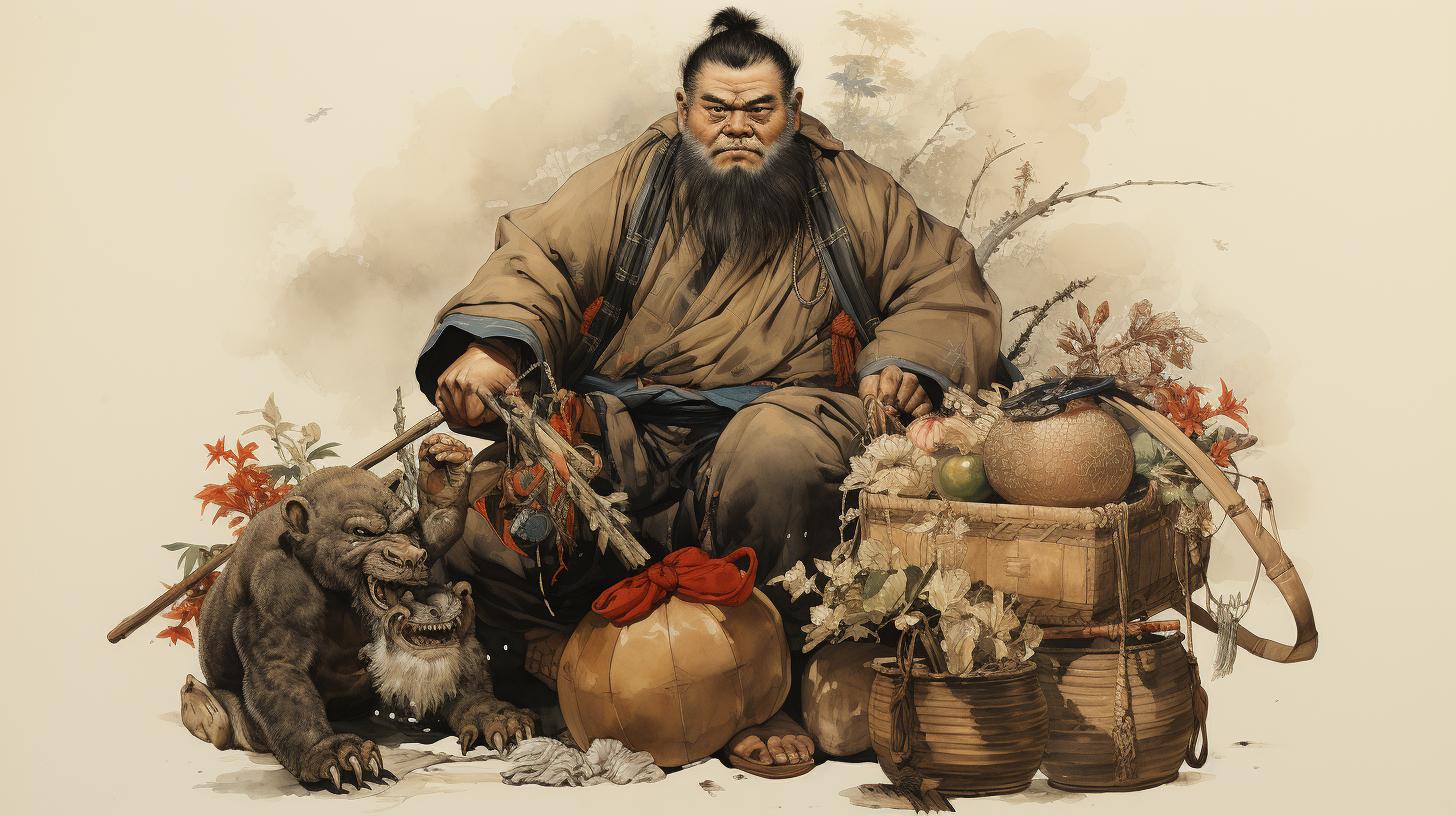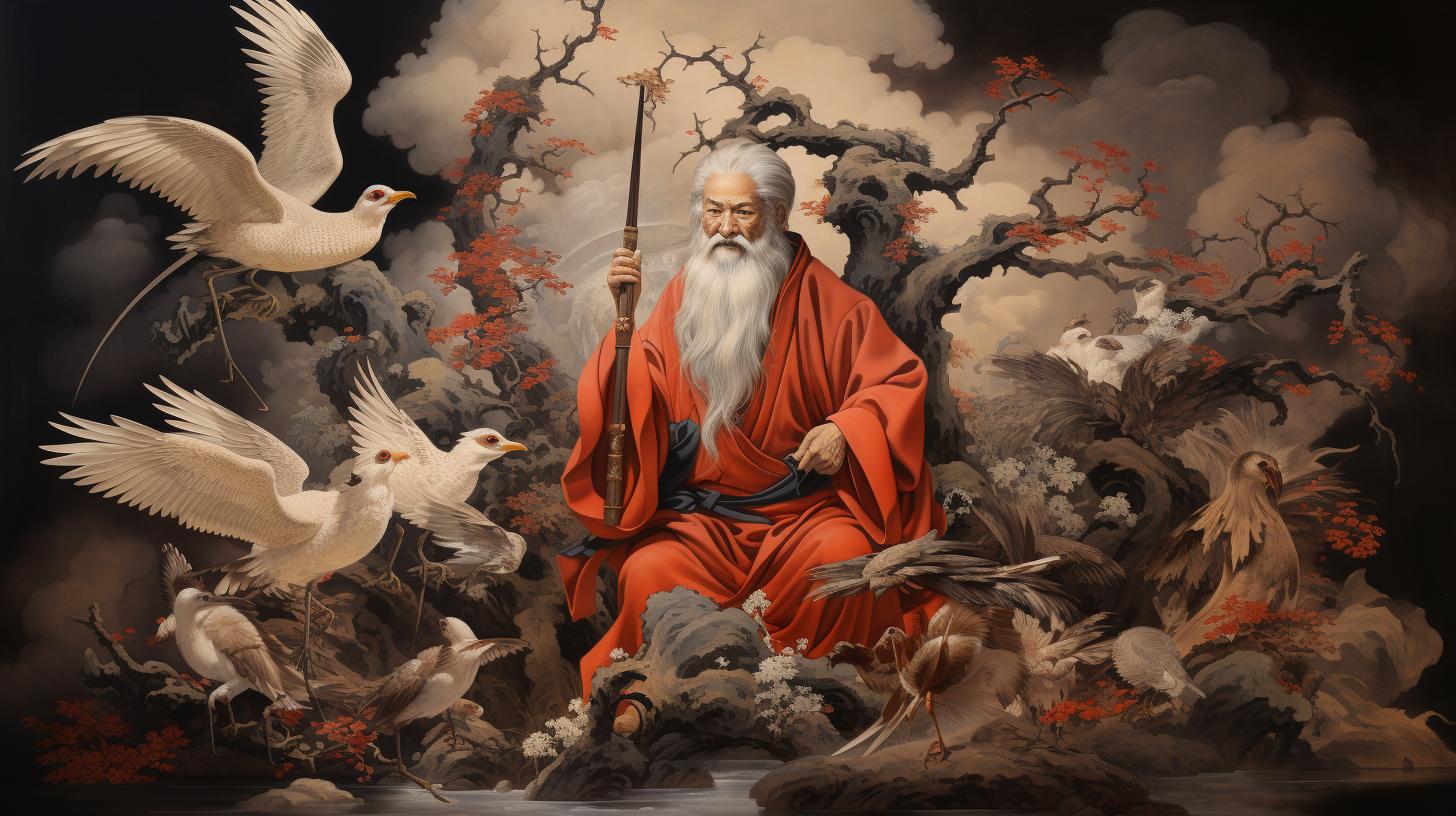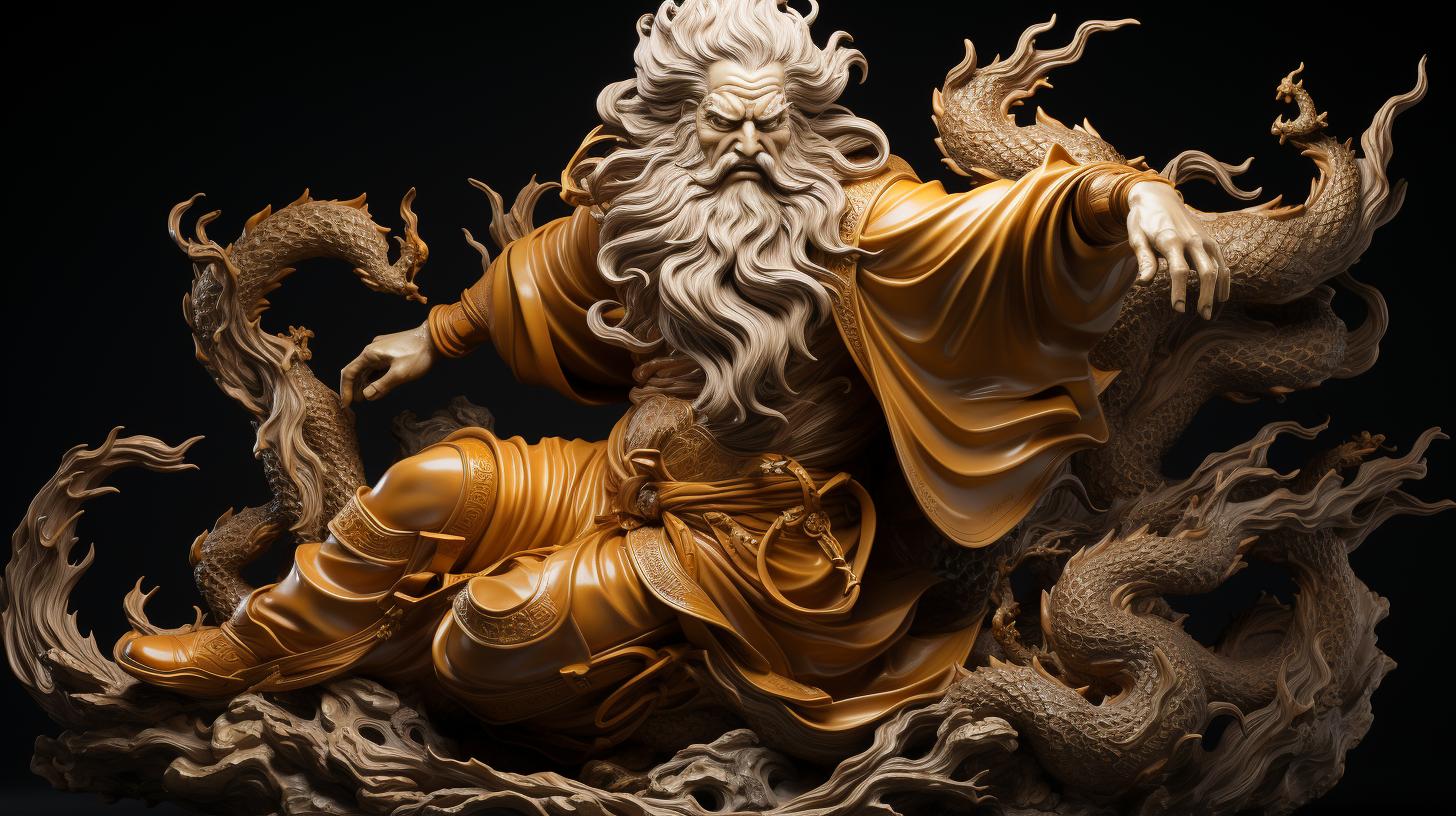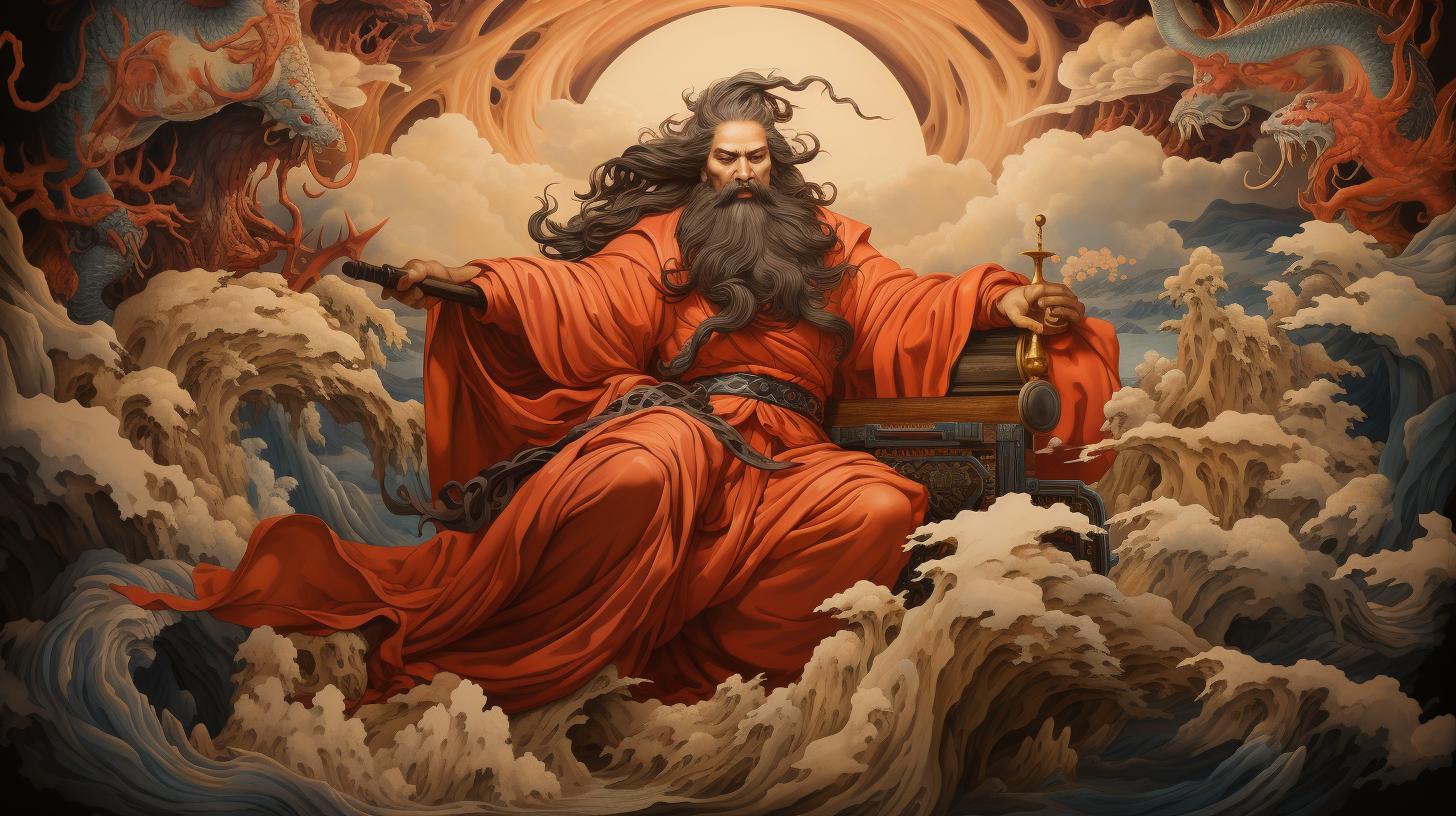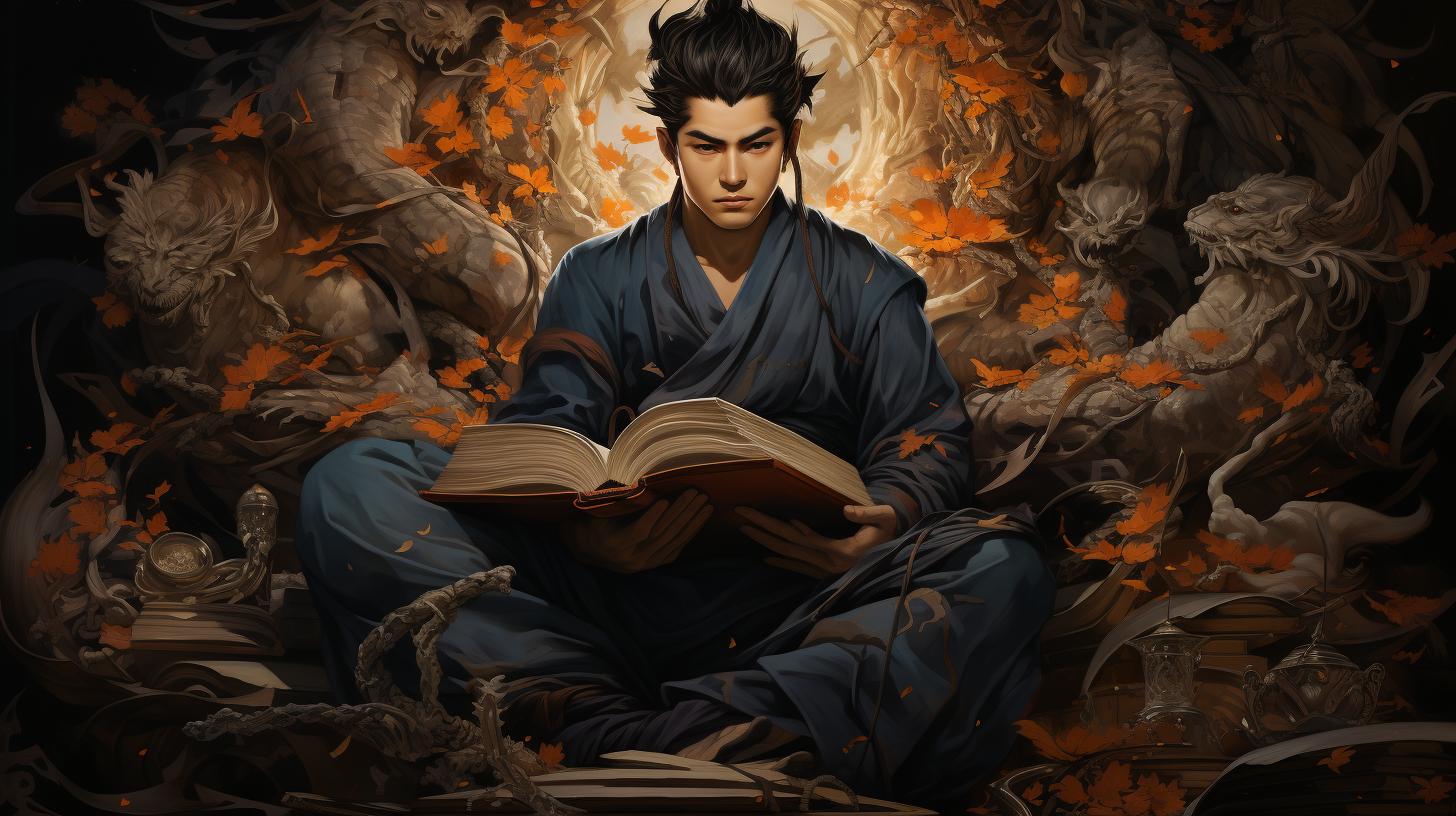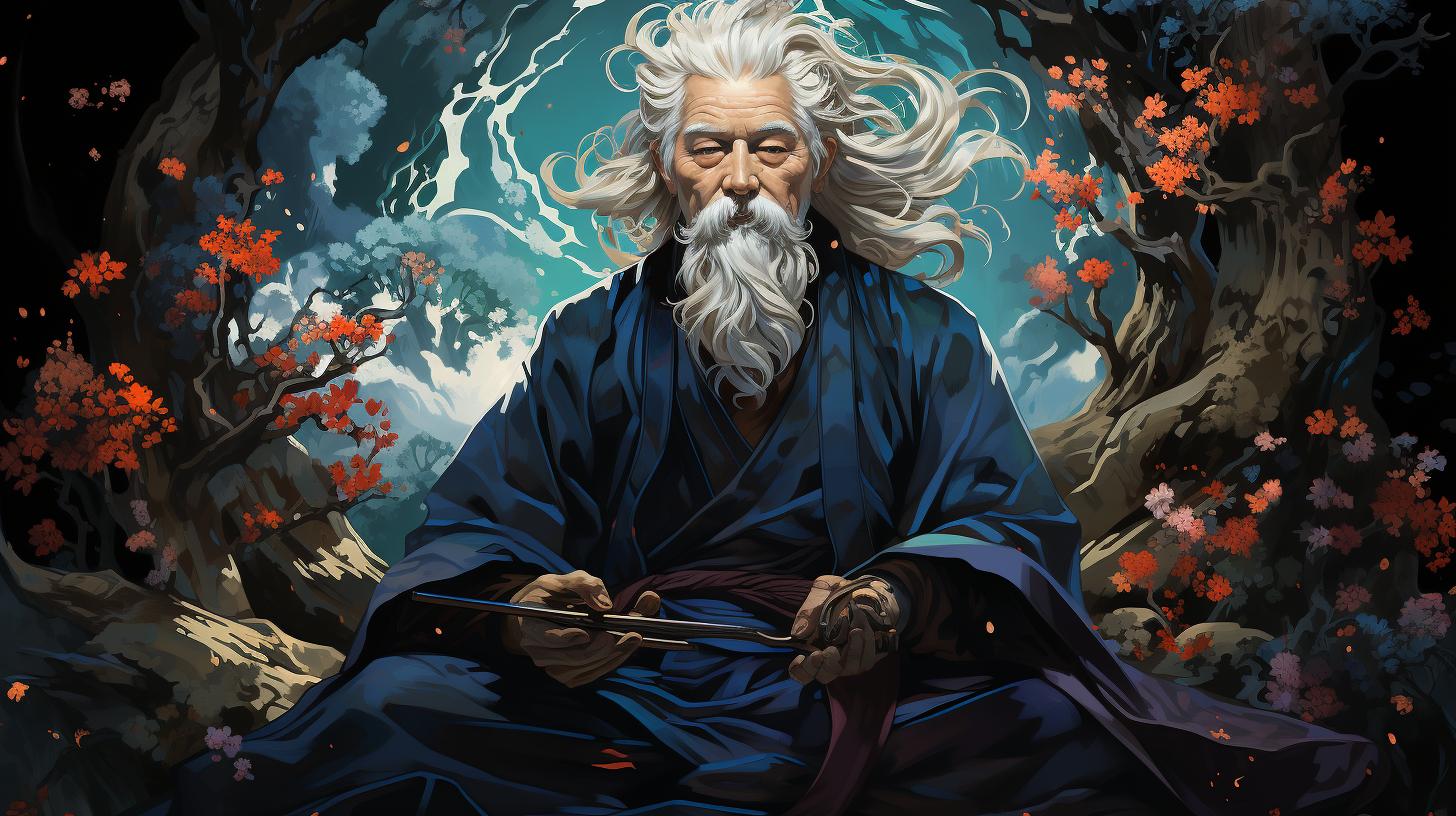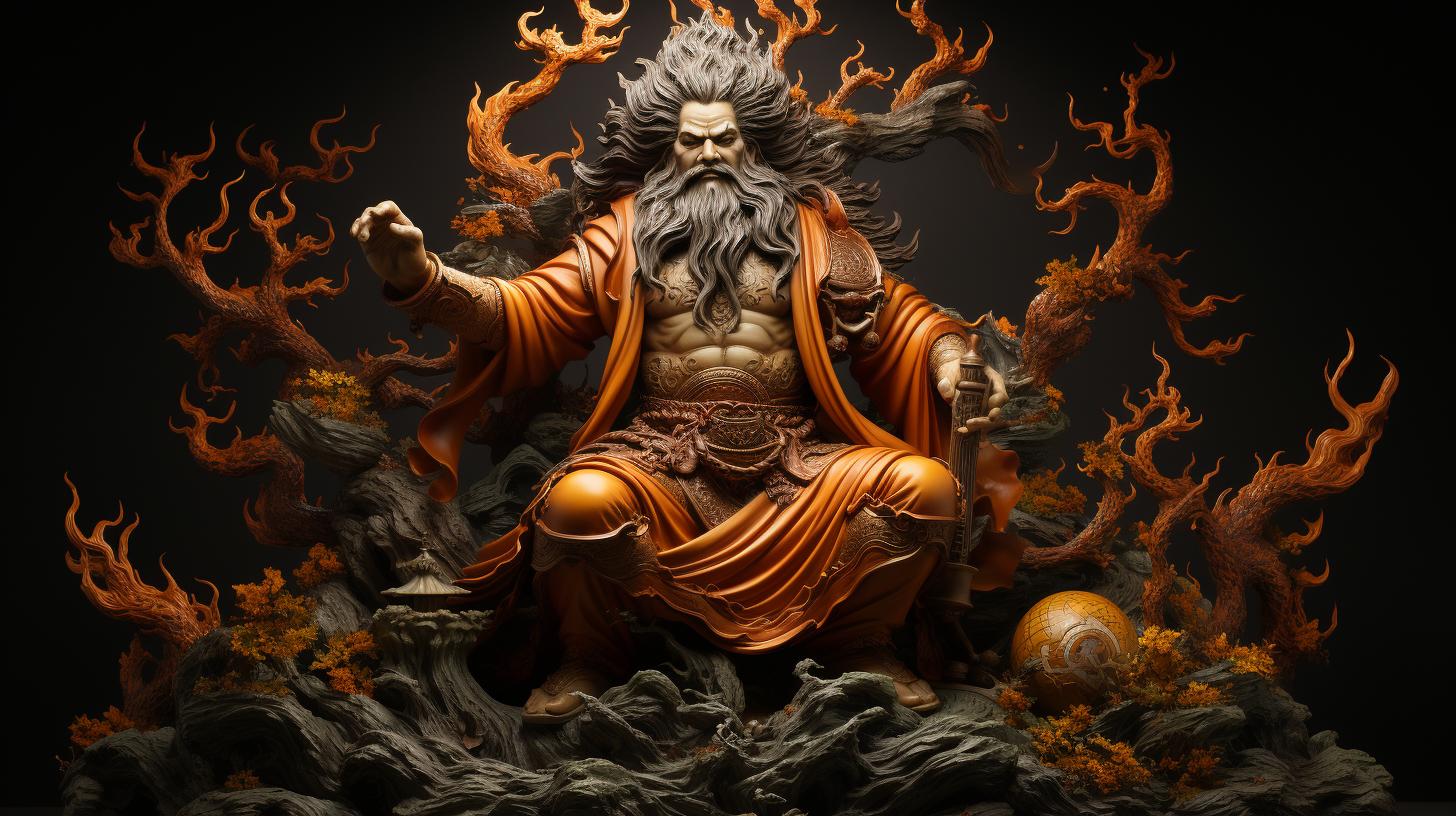Discovering Daikokuten God: The Benevolent Deity of Wealth and Fortune in Japanese Mythology

Daikokuten God is a benevolent deity in Japanese mythology associated with wealth, fortune, and prosperity. He is one of the Seven Lucky Gods in Japan and also the protector of Buddhist monasteries and their kitchens.
Daikokuten has a unique physical appearance, with a plump body, dark skin, and carrying a set of bags filled with treasures and rice on his back. Throughout this article, we will explore the origins, significance, and influence of Daikokuten God in Japanese culture, art, and religion.
Origins and Characteristics of Daikokuten God
Daikokuten God is a deity that holds immense significance in Japanese culture. He is regarded as a benevolent god who symbolizes wealth, fortune, and prosperity. In this section, we will delve into the origins and characteristics of Daikokuten God, exploring his background and the unique traits that distinguish him from other gods in Japanese mythology.
Introduction to Daikokuten God
Daikokuten God is one of the seven lucky gods in Japan and is renowned for his unique physical appearance and benevolent nature. He is often portrayed as a rotund figure with dark skin, carrying a large bag of treasure on his back and using a golden mallet to grant wishes.
Daikokuten God is highly revered in Japanese culture and society and is believed to bring prosperity and good fortune to those who worship him.
The Origins and Influence of Daikokuten God
The origins of Daikokuten God can be traced back to the influence of Hindu deities Mahakala and Shiva in the kingdoms of Nanzhao and Dali. These gods had a significant impact on the development of Buddhism and Shintoism in Japan, contributing towards the creation of a unique blend of spiritual traditions that continue to thrive in Japan today.
Daikokuten God’s influence can be felt throughout the country, with many people venerating him as the deity of wealth and prosperity, as well as the protector of monasteries and their kitchens.
Characteristics and Appearance of Daikokuten God
Daikokuten God is a symbol of compassion, generosity, and good fortune. His rotund body is said to represent abundance and is a reflection of his association with wealth and prosperity.
Moreover, his dark skin and the two rats that accompany him are said to symbolize a bountiful harvest and a full stomach.
Additionally, Daikokuten God is characterized by his jovial demeanor, as well as his possession of a hammer of fortune, which he uses to grant wishes and bestow prosperity upon those who worship him.
Daikokuten God in Japanese Mythology
Daikokuten God is a significant deity in Japanese mythology and is found in different religious traditions, such as folk religion, Esoteric Buddhism, and Shintoism. Despite his multicultural background, Daikokuten’s portrayal remained consistent across time, representing the deity’s role as the god of wealth and prosperity.
Daikokuten God in Japanese Folk Religion
Daikokuten is recognized as one of the most important deities in Japanese folk religion. People use the deity’s image to seek blessings and good fortune. In the Edo period, around the 17th century, Daikokuten became more prominent with the rise of the merchant class.
Folks started to revere him for his association with wealth and good luck.
Daikokuten God and Esoteric Buddhism
Daikokuten is also associated with Esoteric Buddhism. The deity has been known to protect monasteries and offer blessings to the monks. Esoteric Buddhism prayers include reciting mantras to seek blessings and protection from Daikokuten.
Daikokuten God and Shintoism
Daikokuten’s influence goes beyond Buddhism, as the deity is present in Shintoism too. Daikokuten’s image is seen in many Shinto shrines, usually in their kitchens as the deity is regarded as a protector of food and abundance.
In conclusion, Daikokuten God is a well-respected and revered deity in Japanese mythology. The deity’s appearance and characteristics are consistent in different religious traditions like folk religion, Esoteric Buddhism, and Shintoism.
Despite Daikokuten’s various associations, the deity is mainly recognized as a god of wealth and prosperity.
The Seven Lucky Gods and Daikokuten
The lore of Japanese religious and cultural traditions is rich in mythical tales and beliefs. Amongst these, the Seven Lucky Gods stand out as a significant group of deities who are revered for their auspicious powers.
These divine beings are known for their ability to bestow blessings and good fortune upon those who honor and venerate them. They are typically depicted as a group of seven deities, each representing a specific virtue or attribute.
Daikokuten God is one amongst these seven, and his role and symbolism are critical in Japanese folklore.
Who are the Seven Lucky Gods?
The Seven Lucky Gods are a group of deities in Japanese folklore who are also referred to as the Seven Gods of Fortune. This group includes Ebisu, Bishamon, Daikokuten, Fukurokuju, Benzaiten, Hotei, and Jurojin.
Each deity is associated with a particular attribute or quality, such as prosperity, good health, longevity, wisdom, and fertility. Together, they represent a complete spectrum of blessings, which are considered essential for a prosperous and contented life.
Daikokuten’s Role among the Seven Lucky Gods
Daikokuten, being the God of Wealth and Fortune, occupies a central position in this group of seven deities. He is particularly associated with the blessings of wealth, prosperity, and fertility. According to legend, he is the protector of rice fields, farmhouses, and granaries, and has the power to ensure bountiful harvests.
Daikokuten is also believed to have the ability to ward off evil spirits and misfortunes. He is often depicted with his mallet, which is a symbol of his ability to crush evil and dispense blessings upon his followers.
The Symbolism of Daikokuten’s Objects
Daikokuten is recognizable for the objects that he carries with him, which are symbols of his power and blessings. The main object he is depicted with is his mallet, which is known as the Uchide no Kozuchi.
This mallet is considered a powerful talisman that has the ability to grant any wish that the wielder desires. The other objects that he carries are two bags of rice on his back, a large bag of treasure in his hand, and two rats that represent abundance.
These objects symbolize his powers of prosperity, abundance, and fortune. In conclusion, the Seven Lucky Gods and Daikokuten, in particular, have a deep-rooted significance in Japanese culture, religion and traditions. These gods are revered for their blessings of wealth, prosperity, and good fortune.
They represent the essential attributes that are believed to be necessary for a happy and contented life, and are often depicted in the artwork and literature of Japan. Daikokuten, as a benevolent deity, is considered the patron of farmers and agriculture, and his blessings are believed to ensure a bountiful harvest.
His objects, which are symbols of his power, also have deep meanings and are considered talismans of good fortune.
Daikokuten in Japanese Culture
Daikokuten has enormous significance in Japanese culture. He is revered by millions of people not just as a benevolent deity but as a symbol of wealth, good fortune, and prosperity.
Daikokuten in Everyday Life
Daikokuten is worshipped in many households in Japan as the god of wealth and fortune. He is also known as the protector of farmers and is believed to bring good harvests.
People often display his images in their wealth corners, in kitchens, and placed next to their cash boxes.
Daikokuten is also popular in the world of commerce and business. Many companies have adopted him as their mascot and use his image and likeness in their logos, branding, and advertising.
Going into a Japanese supermarket, you will find products such as Daikokuten-branded rice, sake, and other items.
Daikokuten Festivals in Japan
Honoring Daikokuten is an important part of many festivals and events across Japan. One of the most significant is the Daikoku Matsuri festival held every January in Osaka, where a parade of portable shrines is held, and special prayers and fireworks shows take place.
The festival is a celebration of good fortune, and people come from all over Japan and beyond to take part in the festivities.
Daikokuten in Art and Literature
Daikokuten is frequently depicted in Japanese art and literature. He is most commonly portrayed holding a golden mallet, which is believed to bring good luck to its owner. Many Japanese artists and writers have drawn inspiration from Daikokuten’s images, representing him in everything from classic painting to modern mangas.
For instance, Daikokuten appears in the popular video game Okami, as a larger-than-life statue used to restore a broken bridge.
In conclusion, Daikokuten is an integral part of the Japanese culture, revered for his benevolence and his associations with riches and prosperity. He has become a critical figure in Japanese folklore, art, and literature and continues to be highly venerated by the Japanese people.
Legacy and Influence of Daikokuten God
Daikokuten God has had a profound impact on Japanese society, culture, and religion for centuries. This section examines some of the significant ways in which Daikokuten and his legacy have influenced various aspects of Japanese life, including wealth and prosperity, modern Japan, and international recognition.
Daikokuten and Wealth and Prosperity
Daikokuten has become synonymous with wealth and prosperity in Japanese culture. For many centuries, people have been praying to him to bring them good fortune, health, and happiness. His characteristic appearance, carrying bags overflowing with wealth and rice, is a symbol of abundance and plenty.
Many Japanese businesses and homes have statues of Daikokuten to bring prosperity and good fortune. His image can be found on items such as coins, stamps, and household goods, all of which serve as symbols of wealth and abundance.
Daikokuten in Modern Japan
Although Daikokuten’s popularity has waned in modern times due to Japan’s increasing secularization, he remains a significant figure in Japanese spirituality, particularly in Buddhism and Shintoism. Every year, millions of people visit temples and shrines dedicated to him, seeking his blessings.
In addition, the image of Daikokuten often appears in modern Japanese popular culture, including anime, manga, and video games. His image is used in a variety of modern Japanese products, from t-shirts to phone cases, and he remains a symbol of Japanese cultural identity.
Daikokuten and International Recognition
Although Daikokuten is primarily associated with Japanese culture, his influence has spread beyond Japan’s borders. Many people around the world have come to recognize Daikokuten’s image as a symbol of wealth and good fortune.
The deity is sometimes used in Western advertising, particularly in advertisements for businesses located in Japan or for products with a Japanese theme. Additionally, many Westerners have come to appreciate the unique qualities of Daikokuten and his place in Japanese spirituality and culture.
Overall, the legacy and influence of Daikokuten God is a testament to the enduring power of religion and spirituality in shaping the culture and identity of a nation. As Japan continues to evolve, Daikokuten will undoubtedly remain an essential part of the country’s cultural heritage and a symbol of hope and prosperity for generations to come.
Exploring the Significance of the Daikokuten God Statue
Daikokuten God, one of the Seven Lucky Gods in Japanese mythology, is usually depicted holding a golden mallet in his hand and standing on two rice bales or sacks. But his representation in the form of statues is not limited to this depiction.
The History of the Daikokuten Statue
The earliest known statue of Daikokuten was created in the Heian period (794-1185). The statue, made of wood, was discovered at Murō-ji, a Buddhist temple in Nara Prefecture. The statue has now been designated as a National Treasure of Japan.
The Murō-ji statue is believed to be the oldest surviving Daikokuten statue of its kind.
During the Edo period (1603-1868), several temples heavily venerated Daikokuten and placed statues of him in various poses. The most renowned of these statues is the ‘Nara Daikokuten’ statue, which stands at the Tōdai-ji temple complex in Nara Prefecture.
This statue depicts Daikokuten holding the eternal Buddhist jewel known as ‘Hōjō’ in his right hand, while his left hand holds a golden mallet.
The Significance of the Statue at Kyoto’s Mount Hiei
The statue of Daikokuten near the Enryaku-ji temple on Mount Hiei has significant religious and historical importance. The statue, which is also known as the Kōfuku-ji Daikokuten, was created in the Kamakura period (1185-1333) and is considered one of the oldest wooden statues in Japan that depicts Daikokuten.
The statue is kept at the Reihōkan Museum in Enryaku-ji and is designated as a National Treasure of Japan.
History of the Statue
The statue was initially made for the Kōfuku-ji temple in Nara, but it was later transferred to Enryaku-ji in 1571. The statue was then kept in various locations in Enryaku-ji until it was officially placed at its current location in 1935.
Significance for Japanese Buddhism
The statue holds great significance for Japanese Buddhism and is considered emblematic of the god’s role as a protector of the religious faith. The statue is enshrined in the midst of a lush-green pine forest and is flanked by a pair of Rakan (enlightened followers of Buddha) statues.
The statue symbolizes material bounty, and devotees offer prayers to the statue to seek prosperity.
The Role of the Daikokuten Statue in Japanese Buddhism
The statue of Daikokuten plays a significant role in the practice of Japanese Buddhism. The statue represents wealth and prosperity, and it is said that praying to the statue will bring good fortune and financial gain.
The deity is associated with kitchen gods in many ancient cultures and is revered as a protector of the kitchen and food.
The Daikokuten statue is also associated with the concept of Mukōjima, a term that refers to the opposite bank of the Sumida River in Tokyo. The Mukōjima district is regarded as a lucky place, and many people traditionally visit the Daikokuten statue there to pray for good fortune and prosperity.
Conclusion
The Daikokuten statue holds significant importance in the religion and culture of Japan. It represents fortune, prosperity, and material abundance and is revered by many in the country. The statue highlights the pervasive influence of Buddhism and its association with wealth and prosperity among the Japanese people.
The Golden Mallet and its Association with Daikokuten
The golden mallet, also known as Uchide no Kozuchi in Japanese, is a small wooden hammer that has become one of the most recognized symbols of Daikokuten in Japanese culture. This hammer is said to have the power to grant wishes and bring good fortune, which made it a popular object of worship in ancient Japan.
The Story of the Golden Mallet
The legend of the golden mallet dates back to the ancient times when the god of thunder, Takemikazuchi, went to visit the god of rice fields, Inari, in his heavenly abode.
As a gift, Inari offered Takemikazuchi a small wooden hammer, which he took back to earth as a token of goodwill.
Over time, the hammer came to be associated with the god of wealth and prosperity, Daikokuten, who was often depicted carrying the magical mallet in his hand. Its association with Daikokuten is rooted in the idea that the god uses the hammer to create wealth and spread it among the people.
Spirituality and Mythology behind the Golden Mallet
According to Japanese mythology, the golden mallet is believed to have the ability to grant wishes and bring good fortune to those who possess it. It is also believed to be the source of all wealth and prosperity in the world.
One of the most interesting aspects of the hammer’s mythology is its ability to transform into any object its possessor desires. This magical power is said to be rooted in the limitless potential of the human mind, which can manifest itself in various forms of wealth, abundance, and prosperity.
Its Role in Modern Popular Culture
Today, the golden mallet remains a popular symbol of wealth and prosperity in Japanese culture. It is often featured in manga, anime, and video games as a powerful weapon that can defeat enemies and grant the player with good luck and prosperity.
The hammer has also become a popular item among collectors and enthusiasts who value its spiritual significance and artistic beauty. Many artists and craftsmen have created their own versions of the golden mallet, which are often sold as souvenirs to tourists and collectors.
The golden mallet’s association with Daikokuten has made it a beloved symbol of wealth and prosperity in Japan. Its story and mythology continue to inspire people all over the world to embrace their true potential and manifest their deepest desires through the power of positive thinking and action.
The Myth of the Fortune-Robbing
The belief behind fortune-robbing is an ancient Chinese practice that has since spread throughout Japan and surrounding nations. Followers believe that stealing objects or figurines of deities, including Daikokuten, will bring them good luck and fortune.
The Belief behind Fortune-Robbing
The practice of fortune-robbing is based on the idea that the deity figurine possesses an energy field that can be transferred to the owner. By stealing a figurine, the thief takes control of the deity’s good luck and fortune, which results in a transfer of power from the original owner to the thief.
The belief is gained credibility as it is believed that all of the Japanese Seven Lucky Gods figurines get stolen at some point thus making the act of stealling these figurines part of the tradition itself.
The Historical and Cultural Roots of Fortune-Robbing
The historical and cultural roots of fortune-robbing date back to ancient China, where it was believed that figurines possessed a magical energy field. Many Chinese followers would break, sell, or bury figurines in exchange for good fortune and luck.
The practice later migrated to Japan, where it was incorporated with existing Buddhist and Shinto practices, in particular of the japanese Seven Lucky Gods, which, along with other factors, positively influenced the practice to become part of the tradition we know today.
The Significance of Fortune-Robbing in Modern Japan
In modern Japan, fortune-robbing still occurs throughout the country, particularly around popular tourist sites and shrines known for their Seven Lucky Gods figures. Tourists engage in this practice as a way to gain a unique experience and a potential source of good luck.
In fact, many sellers of these figurines secretly encourage the practice as a way to drive up sales. This practice has taken some backlash with locals as since it involves a criminal act of stealing and is thus an illegal practice.
Authorities have gone forward with warning locals and expats that this practice has consequences which they themselves are more than aware of.
Despite the negative impact of fortune-robbing on local communities, it remains a significant part of Japanese culture and mythology. Its existence and impact on Japan’s cultural identity reflect the fusion of ancient Chinese and Japanese beliefs, highlighting the richness and diversity of the country’s spiritual and cultural practices.
Lastly, this tradition can have severe legal implications and visits to Japan must be enjoyed with utmost respect and mindfulness towards Japanese traditions and laws…..

